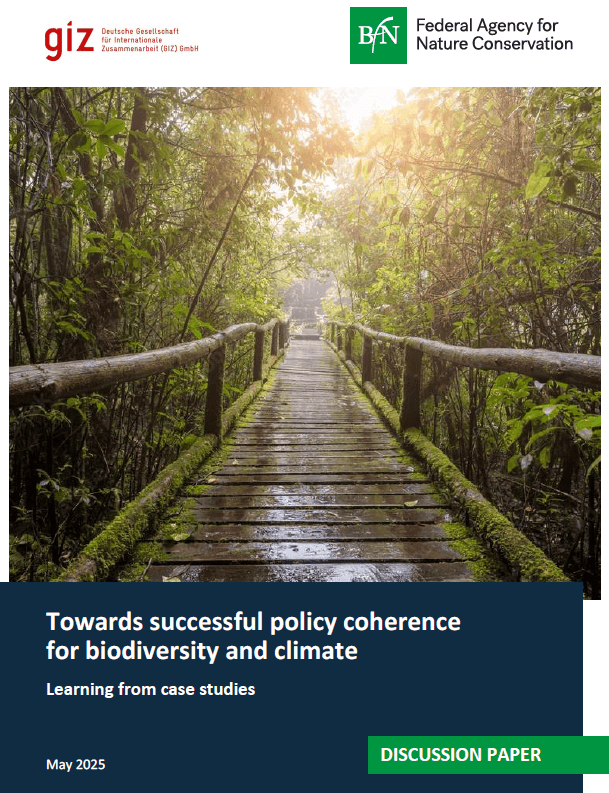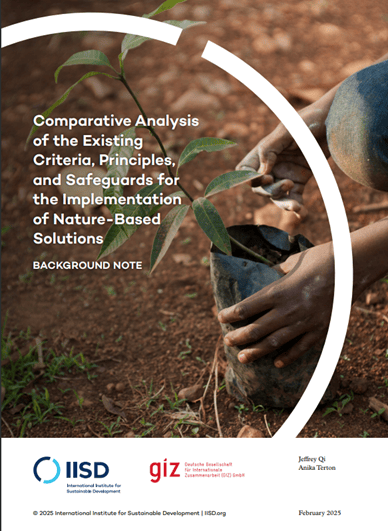Working with nature to adapt to a changing climate
Working with nature to adapt to a changing climate
EbA uses the sustainable management, conservation, and restoration of ecosystems to provide services that enable people to adapt to the impacts of climate change. It is a people-centric concept, but one that acknowledges that human resilience depends critically on healthy ecosystems.
Integrated into an overall adaptation strategy, EbA provides sustainable and cost-effective solutions for people affected by climate change.
Ecosystem-Based Adaptation (EbA) is a nature-based solution that is gaining significant importance in the context of global climate action (e.g. UNFCCC Paris Agreement, Nationally Determined Contributions, National Adaptation Plans) and biodiversity conservation policies (e.g. the Global Biodiversity Framework (GBF) or the Aichi targets). EbA’s distinctive feature is that it links traditional biodiversity and ecosystem conservation approaches with sustainable socio-economic development. As part of an comprehensive adaptation strategy, EbA provides sustainable and cost-effective solutions for helping people adapt to climate change. “Comprehensive” means that it recognizes the complexity in the impact of climate change on socio-economic-environmental systems, and proposes solutions based on a multi-sectoral and multi-level dialogue. EbA is a people-centric concept, but one that acknowledges that human resilience depends critically on the integrity of ecosystems.
Illustration 1: Qualification criteria for ecosystem-based adaptation measures
In the context of increasing political commitment and funding, it is essential to sharpen the understanding of what qualifies as EbA. The Framework for Defining Qualification Criteria and Quality Standards identifies 3 elements and 5 qualification criteria.
EbA falls under the umbrella concept of Nature-based Solutions (NbS), but is only one form of NbS that focuses specifically on adaptation.
Learn more about EbA as a NbS to adaptation in this factsheet.
The Global Project Mainstreaming EbA has developed a variety of publications on EbA, an overview is available here.
Ecosystem-based approaches to climate change adaptation (and disaster risk reduction, Eco-DRR) use ecosystem services to help people adapt to climate change and reduce disaster risk. This is done through the sustainable management, conservation and restoration of ecosystems and biodiversity. Ecosystems provide crucial services to society, particularly regulating and supporting services that help people adapt and reduce risk (TEEB, 2010):
These are some of the areas of impact and benefits from EbA measures:
Sectoral applications of EbA:
EbA in Latin America:
Programs such as “Scaling up Ecosystem-based Adaptation Measures in rural Latin America” seek to increase resilience to climate change in vulnerable communities and ecosystems in Ecuador, Guatemala and Costa Rica. Likewise, the Peruvian program “Escalando AbE Montaña” (Scaling EbA Mountain) has enabled the establishment of experiences in this field in other areas of Latin America.
Urban and rural applications:
Similarly, examples of specific measures could be contextualized according to the environment in which they are developed and impact
Synergies between AbE and Eco-DRR:
EbA and Eco-DRR (SCBD, 2019) can also enhance biodiversity and nature conservation.
For a visual understanding of these benefits and applications, please consult also the document “Why working with nature pays off” (GIZ, 2022), which illustrates the interconnections between EbA and the aforementioned sectors.
systems (GIZ 2025)
Based on its operational experience worldwide in promoting (ecosystem-based) adaptation, GIZ developed the following conceptual framework for mainstreaming EbA:
Illustration 3: Conceptual model for the integration of EbA at scale, also called the mainstreaming cycle (GIZ, 2023).
The 3 main phases: 1. planning, 2. implementation and 3. monitoring, evaluation and learning run in a circular way, which allows for continuity in climate change adaptation efforts, making adjustments to strategies as new information becomes available. Adequate governance that supports the 6 steps is the basis for ensuring comprehensiveness and inclusiveness (including concepts such as climate justice and “leave no one behind”). Capacity building of stakeholders and the availability of funding and incentives are success factors for the effectiveness and sustainability of the strategies resulting from this cycle.
Phase 1 – Planning: Composed of 4 steps, it allows analyzing contexts, structures and development processes in light of the “climate and ecosystem lens”, looking at how ecosystem conservation and restoration can respond to climate risks, increasing the resilience of vulnerable groups, communities and sectors. Tools such as the Risk and Vulnerability Sourcebook, participatory cost-benefit analysis and multi-criteria analysis allow decision-makers and implementers to identify the most urgent and strategic interventions.
Phase 2 – Implementation: Requires sound operational planning, e.g., based on a theory of change, participation of key stakeholders, coordination mechanisms with government partners and other stakeholders in advance, and relying on capacity building and short, medium and long-term financing.
Phase 3 – Monitoring, Evaluation and Learning: A well-designed and funded monitoring and evaluation system for long-term operation is the basis for determining the appropriateness and effectiveness of the interventions selected and implemented in the previous phases. The generation of evidence is necessary to direct financial and social investments in future climate change adaptation efforts. More detail on the four key considerations and other aspects in this Guide for Monitoring and Evaluation of Ecosystem-based Adaptation Interventions.
Adaptation Community provides tools and methods that can be used at each step. The information on this page is aligned with the CBD Voluntary Guidelines for the Design and Effective Implementation of Ecosystem-based Approaches to Climate Change Adaptation and Disaster Risk Reduction.
UNFCCC and the Paris Agreement: Ecosystem-based approaches are a promising option for sustainable and efficient adaptation to climate change. EbA encompasses policies and measures that take into account the role of ecosystem services in reducing societal vulnerability through multi-sectoral and multi-level approaches. The Paris Agreement requires all Parties to engage in adaptation planning and implementation through the national adaptation plan (NAP) process including vulnerability assessments and monitoring and evaluation. The NAP process is an important entry point for EbA as it aims to integrate climate change adaptation into development decisions and investments. It can also form the backbone for implementing the adaptation component of a country’s Nationally Determined Contribution (NDC). Some of the NDCs mention EbA explicitly, while others refer to using ecosystem services as a means for adaptation. There are at least three ways to consider biodiversity and ecosystem services, and thus EbA, in the NAP process:
CBD – Convention on Biological Diversity: The CBD plays a fundamental role for all nature-based approaches. Coherent national policies and aligned reporting on the conventions can enhance the uptake of EbA considerably on national and international levels. Respective policy measures should also translate into subnational planning and implementation. National Biodiversity Strategies and Action Plans (NBSAPs) are the principal instruments for implementing the Convention at the national level (CBD, Article 6). The focus for integration of biodiversity concerns into key sectors in the NBSAPs so far has been on improving environmental outcomes and reducing environmental impacts. However, biodiversity mainstreaming through the NBSAPs can also lead to important outcomes related to climate change adaptation and mitigation, poverty reduction, improved health and wellbeing, and greater social equity.
At the 15th Conference of the Parties of the CBD – COP15, held in Kunming and Montreal – a new Global Biodiversity Framework (GBF) was adopted in December 2022. The GBF provides a strategic vision for 2050 and a new set of 23 international targets for the conservation, protection, restoration and sustainable management of biodiversity and ecosystems until 2030. The role of the framework for biodiversity conservation can be compared to the role of the Paris Agreement for change. Member countries of the CBD will now update their National Biodiversity Strategies and Action Plans (NBSAP) to implement the GBF.
United Nations International Strategy for Disaster Reduction (UNISDR) and the Sendai Framework for Disaster Risk Reduction: The concepts and practice of EbA and Ecosystem-based Disaster Risk Reduction (Eco-DRR) have been developed and refined in recent years as integrative approaches to reduce the risk of climate-related and other types of hazards. These approaches emphasise the importance of biodiversity and ecosystems in reducing risk, and build on other practices such as conservation and ecosystem restoration which seek to increase the resilience of ecosystems for the benefit of people. Eco-DRR operates in line with the Sendai Framework for Disaster Risk Reduction 2015-2030, which encourages “ecosystem-based approaches…to build resilience and reduce disaster risk”. Both EbA and Eco-DRR are part of a multi-disciplinary, cross-cutting approach. Cooperation between the two fields enables stronger results in terms of increased resilience. Shared knowledge and learning, capacity building and a greater ability to design interventions that deliver multiple benefits are just some of the options through which resilience can be improved.
Sustainable Development Goals (SDGs): The SDGs are a universal call to action to end poverty, protect the planet and ensure that all people enjoy peace and prosperity. Many of the SDGs are directly linked to the health and biological diversity of ecosystems and the services they provide. Often, the most disadvantaged and marginalised sections of society are highly dependent on ecosystems to support their livelihoods. EbA can provide sustainable, climate resilient, nature-based solutions that span many of the global challenges the SDGs seek to address, optimising synergies and reducing trade-offs
National Biodiversity Strategy and Action Plan (NBSAP): NBSAPs provide strategic guidance on the protection and management of biodiversity and are the main tool guiding actions to implement the Global Biodiversity Framework at the national level. Countries that are in the revision process of their NBSAPs have the opportunity to draw closely on their NAPs and associated climate risk assessments to understand and incorporate detailed information on ecosystem vulnerabilities and risks under different climate scenarios.
Nationally Determined Contributions (NDC): NDCs were established under the Paris Agreement and are the plans in which each country describes and communicates its post-2020 climate actions. NDCs serve the dual purpose of setting targets and an action plan to reduce emissions and include information on adaptation to climate change. Countries must communicate new NDCs in 2025 that aim to show progress beyond their current NDCs and reflect the highest possible ambition. For countries that have included an adaptation component in their NDCs, the NAP process and its results could be used to improve the quality of adaptation-related information in NDCs.



You need to load content from reCAPTCHA to submit the form. Please note that doing so will share data with third-party providers.
More InformationYou need to load content from reCAPTCHA to submit the form. Please note that doing so will share data with third-party providers.
More InformationYou are currently viewing a placeholder content from Google Maps. To access the actual content, click the button below. Please note that doing so will share data with third-party providers.
More InformationYou are currently viewing a placeholder content from Google Maps. To access the actual content, click the button below. Please note that doing so will share data with third-party providers.
More InformationYou are currently viewing a placeholder content from Mapbox. To access the actual content, click the button below. Please note that doing so will share data with third-party providers.
More InformationYou are currently viewing a placeholder content from OpenStreetMap. To access the actual content, click the button below. Please note that doing so will share data with third-party providers.
More Information